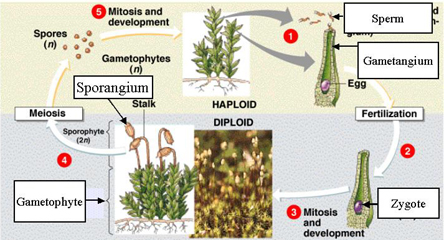
Biology 101 Autumn Quarter 2001
Sample Questions for Examination 3
___B___ |
1. |
In plants vascular
tissue that transports sugars from the leaves to the rest of the plant is
called: |
|
|
A. |
xylem |
|
|
B. |
phloem |
|
|
C. |
transport
tissue |
|
|
D. |
stomata |
|
|
E. |
none of the
above |
___C___ |
2. |
Which of the following
adaptations to terrestrial existence is/are found in
mosses? |
|
|
A. |
a female gametophyte
that remains enclosed in the sporangium, |
|
|
B. |
a mechanism for
uniting gametes that eliminates the need for
water, |
|
|
C. |
spores that disperse
without the need for water, |
|
|
D. |
vascular conducting
tissue,
|
|
|
E. |
both A and
C, |
|
|
F. |
both C and
D, |
|
|
G. |
A, B, C &
D |
___E___ |
3. |
The product of natural
selection is the adaptation of populations of organisms to their
environment. Which of the
following are required to produce this? |
|
|
A. |
Large numbers of
individuals in the population, |
|
|
B. |
an interaction between
the environment and the variability inherent among the individual
organisms making up a population, |
|
|
C. |
Small amounts of
environmental change, |
|
|
D. |
differential success
in reproduction, |
|
|
E. |
B and
D. |
___C___ |
4. |
The type of life cycle
seen in plants is called: |
|
|
A. |
gametophyte
production, |
|
|
B. |
cyclic
reproduction, |
|
|
C. |
alternation of
generations, |
|
|
D. |
crossing over and
recombination, |
|
|
E. |
either A or
D. |
5. Name the two groups of
slime moulds (1pt each). ____plasmodial_________________________ _____cellular________________________
6. Write in each box what their attached arrow points to (2pts each) on this diagram of the moss life cycle.

___B___ 7. How is conifer pollen
distributed from the male cone to the female cone? A. By
insects B. By
wind C. By
water
|
___A___ |
8. |
We classify organisms
by genus and species. What
category do we use to group similar genera? |
|
|
A. |
Family. |
|
|
B. |
Order. |
|
|
C. |
Classes. |
|
|
D. |
Phyla. |
9. Write in each box what their attached arrow points to (2pt for each) on this diagram of the cross-section of a young pine stem.

____A__ 10. We classify organisms
by genus and species. What
category do we use to group similar genera? A. Family. B. Order. C. Classes. D. Phyla.
|
___D___ |
11. |
Which of the following
species are not gymnosperms? |
|
|
A. |
Ginko
biloba |
|
|
B. |
Sequoiadendron
giganteum |
|
|
C. |
Welwitschia
mirabilis |
|
|
D. |
Ceratopteris
richardii |
|
|
E. |
Pinus
attenuata |
|
|
F. |
C and D.
|